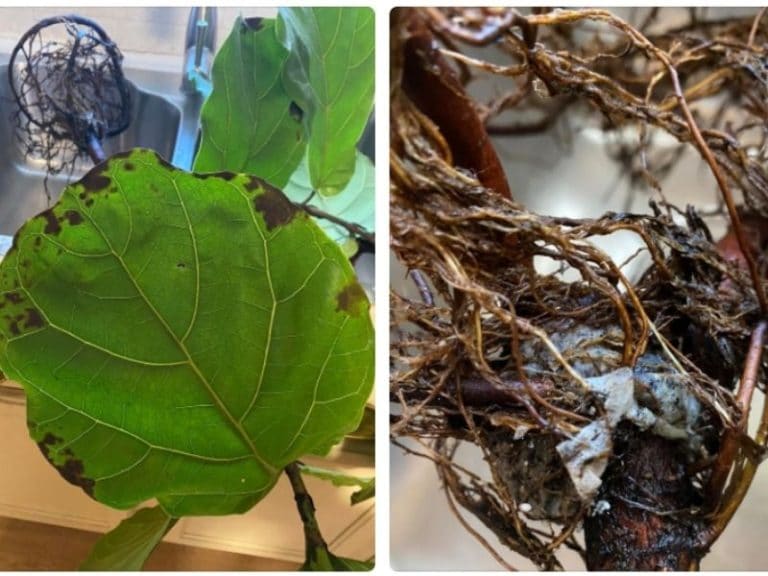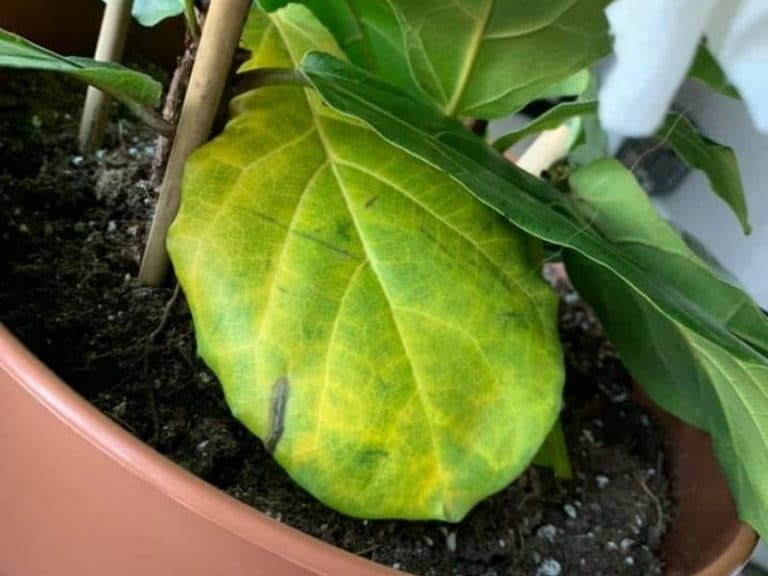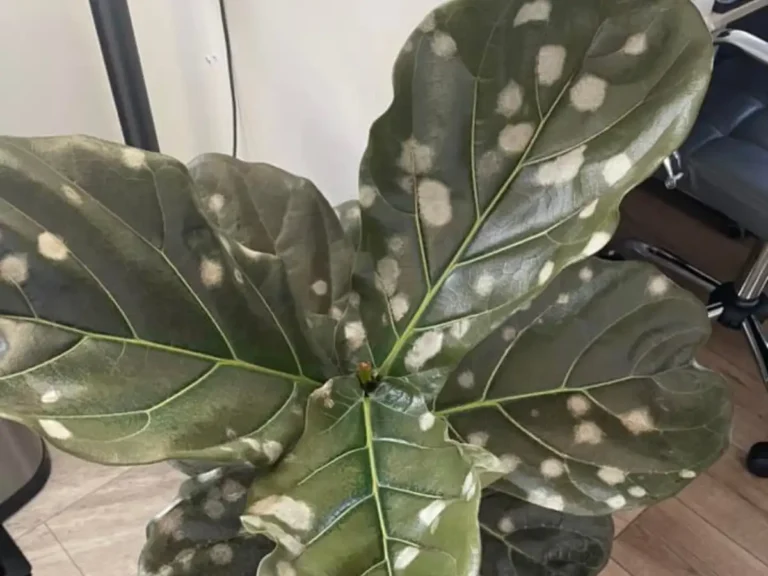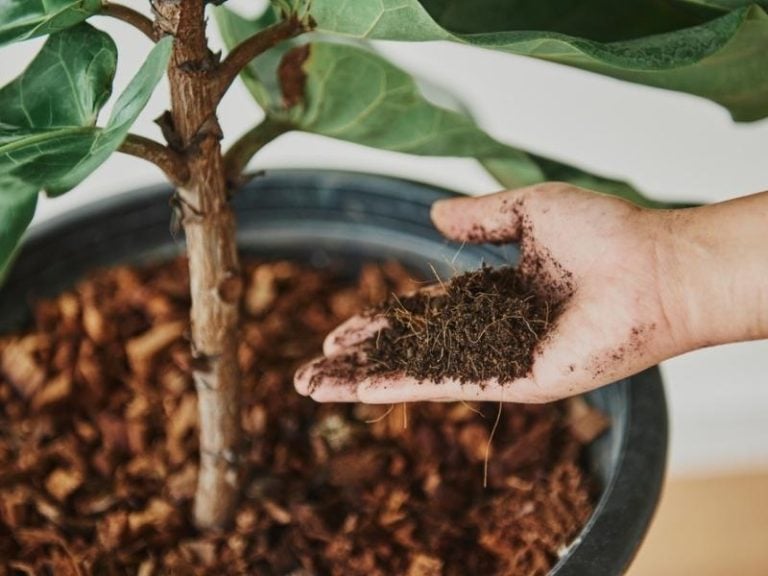How to Get Rid of Spider Mites on Fiddle Leaf Fig
Spider mites (Tetranynchus utricae Koch) survive by attaching themselves to the foliage of plants like fiddle leaf figs where they cause damage that includes leaf loss and discoloration. It’s important to deal with spider mite invasions as quickly as possible due to the pests’ rapid reproduction and ability to spread to other plants quickly.
Apply a jet of cold water from a hose to dislodge the spider mites on your fiddle leaf figs paying more attention to the undersides of the leaves where they hide. Repeat this remedy 3 times a week for the best results. Alternatively, mist the plant with neem oil to kill the spider mites.
Signs of spider mites on fiddle leaf fig
You can tell if your fiddle fig leaves are suffering from spider mite infestation by carefully looking at the leaves. A key indicator of spider mites on fiddle leaf figs is small brown or dark red dots on the leaves.
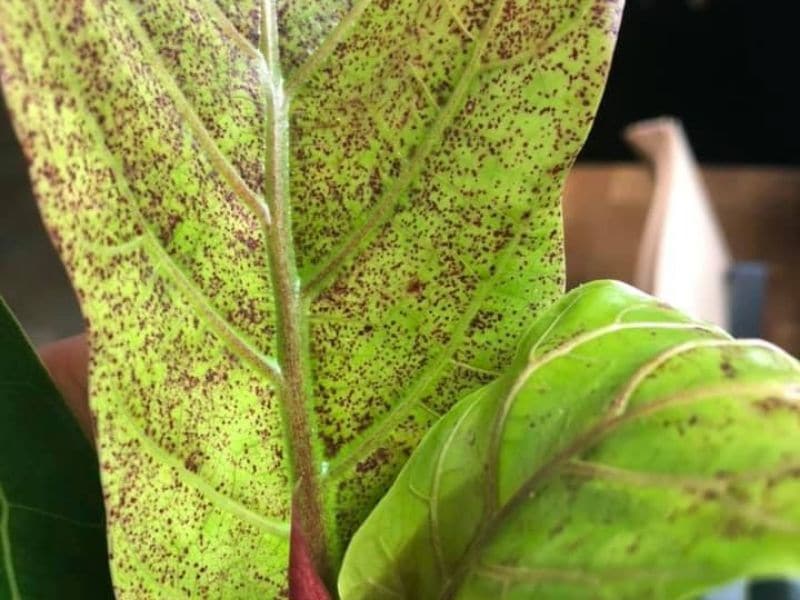
Here are the signs in detail:
Dark spots on the leaves
The pests feed on chlorophyll, suck sap, and can reproduce quickly. The creatures are usually small, so identifying them in small numbers can be challenging.
However, if an infestation occurs, the spider mites can lay numerous eggs, often appear as white clusters (dots/spots) on leaf edges and within the dips of leaves veins.
Curling leaves
Plants suffering from a spider mite infestation will often display signs of poor health – curling leaves, leaf fall, yellowing, etc. It is necessary to first check for the pests before deciding on a treatment option.
Reddish brown spots on the undersides of leaves
If you suspect that your plant is suffering from a spider mite infestation, you can try running a white paper towel across the leaf surface. It can be challenging to see them moving around (the average size of a spider mite is less than 1mm).
Run a white paper towel through them to check for red, brown smudges; this is a clear indicator of a spider mite problem.
Presence of spider mite webs
Another indicator of spider mite infestation on your plant involves checking for spider mite webs. Bugs attach minute filaments to their eggs to keep them within the plant.
Silvery patterns will appear on the leaves, particularly where the stem meets the stalk, near dips, along leaf edges, and along veins on the leaf underside.
You can also use a hand lens, a magnifying glass to analyze your leaves and check for potential spider mite infestations. The mites look like miniature white, red, black, or tan-colored spiders spread out across the sensitive areas of your plant.
How to treat spider mites on fiddle leaf fig
A wide range of spider mite treatments is available on the market. Most pest control techniques involve using insecticide spray to eradicate the insects and keep them from spreading to other plants.
Here’s how to treat spider mites on fiddle leaf figs
1: Spray cold water over your plant
Spray affected plants regularly with water to knock off the insects from your plant. Inspect the undersides of leaves as well as stalks and their bases thoroughly to eliminate pests.
Spider mites don’t like cold water (and cold conditions). Move your houseplant outside and spray continuously using a water hose and pay attention to the sensitive regions where the infestation is more severe. Keep the plant in a colder section of the house with the water still dripping off. In most cases, you might notice the mites slowly detaching themselves and moving away from the wet zones of your plant.
Spraying water is also an excellent way of removing dust, spider mite eggs, and other contaminants that might encourage the infestation of your plant.
2. Mist the fiddle leaf fig with neem oil
Using insecticide spray is a sure way of eradicating spider mites from your fiddle leaf figs. You can opt between chemical insecticides or go for an organic solvent such as neem oil.
You only need the oil, water, and an emulsifying agent (such as a mild liquid soap). Use 1 quart of water to dilute one teaspoon of neem oil and 1-3ml of liquid soap emulsifier. Add the soap solution to the water, shake before adding the neem oil concentrate in ideal amounts.
It’s crucial to first test the potency of your solution before spraying the ensemble of the plant. You can start by dousing a few leaves, giving it time (10-15 hours) before you move on to other parts of your plant. Make sure to thoroughly coat the affected surface with the solution for an effective remedy to the problem.
It is best to use chemical insecticide solutions per the manufacturer’s instructions.
3. Repeat the insecticidal treatment
Spider mites can reproduce quickly. It is crucial to follow up treatment sessions at least once a week. You can give the plant at least four days to allow the plant to recover before assessing its condition.
If you suspect that there could still be some spider mites left on your plant, repeat step 2 and mist the affected surfaces again. As well as separating the affected plant from other plants, pests are easy to migrate from one plant to another.
There are several alternative techniques for dealing with a spider mite infestation. You can control spider mite populations in several ways, including rubbing the leaf surfaces with alcohol and introducing naturally occurring predators (such as ladybugs).
Additional treatment methods include using essential oils (such as spearmint and rosemary) to keep the pests off your plants or opting for chemicals such as dichotomous earth, which can be particularly effective in exterminating the spider mites on fiddle leaf figs while still in the soil.
Note:
It’s vital to consider the underlying factors of a spider mite infestation. Examples of the primary causes of spider mite infestations include dust, underwatering, and the application of too much nitrogen/phosphorous fertilizer that attracts the pests.
Household pets are also substantial contributors to the spread of spider mites as the insects occasionally cling to their fur. Preemptive action can help mitigate the spread of spider mites and help to keep your fiddle leaf figs in good health.
Can spider mites kill fiddle leaf figs?
Spider mites can kill fiddle leaf figs if left untreated for a long period. The pests feed off plant cells and can cause damage to leaves, plant veins, and other vital parts of your plant.
Plant sap is rich in nutrients. A spider mite infestation limits the amount of fluid circulating to other parts of your plant and causes it to bleed out and deteriorate its health. Luckily, it is possible to eradicate spider mites from your plant using a variety of methods.
It is best to isolate the plant first if you suspect a spider mite infestation before working on a viable solution.
How to remove spider mite eggs from the plant
A female spider mite can lay about 20 eggs in a day (and has an average lifespan of about four weeks). The eggs take about three days to hatch and are easily adaptable to chemical pesticides (which can become ineffective if you only use one type).
You can opt for different methods when dealing with spider mite eggs. An ideal solution involves applying alcohol to the affected surface. Alcohol is a safe and inexpensive solution that evaporates quickly and does not harm your plant.
Additionally, you can use a neem oil spray, chemical insecticides, and biological predation (such as thrips, pirate bugs, etc.) as ideal remedies for getting rid of spider mite eggs.


